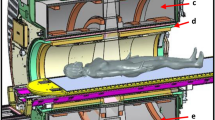Abstract
Some serious radiation accidents have occurred around the world during the delivery of radiotherapy treatment. The regrettable incident in Panama clearly indicated the need for independent monitor unit (MU) verification. Indeed the International Atomic Energy Agency (IAEA), after investigating the incident, made specific recommendations for radiotherapy centres which included an independent monitor unit check for all treatments. Independent monitor unit verification is practiced in many radiotherapy centres in developed countries around the world. It is mandatory in USA but not yet in Australia. This paper describes development of an independent MU program, concentrating on the implementation of the Enhanced Dynamic Wedge (EDW) component. The difficult case of non centre of field (COF) calculation points under the EDW was studied in some detail. Results of a survey of Australasian centres regarding the use of independent MU check systems is also presented. The system was developed with reference to MU calculations made by Pinnacle 3D Radiotherapy Treatment Planning (RTP) system (ADAC-Philips) for 4MV, 6MV and 18MV Xray beams used at the Newcastle Mater Misericordiae Hospital (NMMH) in the clinical environment. A small systematic error was detected in the equation used for the EDW calculations. Results indicate that COF equations may be used in the non COF situation with similar accuracy to that achieved with profile corrected methods. Further collaborative work with other centres is planned to extend these findings.
Similar content being viewed by others
References
McKenzie, A. L.,Would the two most serious radiotherapy accidents in the UK have occurred under ISO 9000?, in Radiation Incidents, Faulkner, K. and Harrison, R. M., British Institute of Radiology, London, 1996.
IAEA,Lessons learned from accidental exposures in radiotherapy, Safety Series Report No. 17, International Atomic Energy Agency, Vienna, 2000.
Vatnitsky, S., Lopez, P. O., Izewska, J., Meghzifene, A. and Levin, V.,The radiation overexposure of radiotherapy patients in Panama 15 June 2001, Radiother. Oncol. 60, 237–238, 2001.
ACPSEM,Submission to Generational Review of the South Australian Public Health Care System, Australasian College of Physical Sciences and Engineers in Medicine, SA Branch, 2002. http://www.dh.sa.gov.au
International Atomic Energy Agency,TRS-398 Absorbed Dose Determination in External Beam Radiotherapy: An International Code of Practice for Dosimetry based on Standards of Absorbed Dose to Water, IAEA, Vienna, 2000.
International Electrotechnical Commission, Medical Electrical Equipment,Dosimeters with ionisation chambers as used in radiotherapy, Standard IEC-60731, IEC, Geneva, 1977.
Mackie, T. R., Scrimger, J. W. and Battista, J. J.,A convolution method of calculating dose for 15MV x-rays, Med. Phys. 12, 188–196, 1985.
Papanikolaou, N., Mackie, T. R., Meger-Wells, C., Gehring, M. and Reckwerdt, P.,Investigation of the convolution method for polyenergetic spectra, Med. Phys. 20, 1327–1336, 1993.
Kalend, A. M., Wu, A. and Maitz, A.,Separation of dosegradient effect from the beam-hardening effect on wedge factors in photon fields, Med. Phys. 17, 701–704, 1990.
Gibbons, J. P.,Calculation of enhanced dynamic wedge factors for symmetric and asymmetric photon fields, Med. Phys. 25(8), 1411–1418, 1998.
Petti, P. L. and Siddon, R. L.,Effective wedge angles with a universal wedge, Phys. Med. Biol. 30, 985–991, 1985.
Waldron, T. J., Boyer, A. L. and Wells, N. H.,Calculation of dynamically wedged isodose distributions from segmented treatment tables and open field measurements, Med. Phys. 21, 873, 1994.
Klein, E., Low, D., Meigooni, A. and Purdy, J.,Dosimetry and clinical implementation of dynamic wedge, Int. J. Radiat. Oncol. Biol. Phys. 31, 583–592, 1995.
Liu, C., Zhu, T. C. and Palta, J. R.,Characterising output for dynamic wedges, Med. Phys. 23(7), 1213–1218, 1996.
Liu, C., Siyong, K., Kahler, D. L. and Palta, J. R.,Generalised monitor unit calculation for the Varian enhanced dynamic wedge field, Med. Phys. 30(7), 1891–1896, 2003.
Yu, M. K.,Analytical representation of enhanced dynamic wedge factors for symmetric and asymmetric photon fields, Med. Phys. 29(11), 2606–2610, 2003.
Duggan, L., Kron, T. and Howlett, S.,Radiotherapy treatment checking procedures throughout Australasia: results of a survey, Aust. Phys. Eng. Sci. Med. 19, 67–73, 1996.
International Atomic Energy Agency,Standards and Codes of Practice in Medical Radiation Dosimetry, Vol I. Proceedings of an IAEA International Symposium, Vienna, 2002.
Miften, M., Wiesmeyer, M., Beavis, A., Takahashi, K. and Broad, S.,Implementation of enhanced dynamic wedge in the focus RTP system, Med. Dosim. 25(2), 81–86, 2000.
Murray, B., McKenzie, M., Field, C. and Robinson, D.,A simple method of improving calculation accuracy for enhanced dynamic wedge factors, Cross Cancer Institute, Edmonton. Canada.Private communication.
Haslam, J. J., Bonta, D. V., Lujan, A. E., Rash, C., Jackson, W. and Roeske, J. C.,Comparison of dose calculated by an intensity modulated radiotherapy treatment planning system and an independent monitor unit verification program, J. Appl. Clin. Med. Phys 4(3), 224–230, 2003.
Koken, P. W., Heukelom, S. and Cuijpers, J. P.On the practice of the clinical implementation of enhanced dynamic wedges, Med. Dosim. 28(1), 13–19, 2003.
Prado, K. L., Kirsner, S. M., Kudchadker, R. J., Steadham, R. E. and Lane, R. G.,Enhanced dynamic wedge factors at off-axis points in asymmetric fields, J. Appl. Clin. Med. Phys. 4 (1), 75–84, 2003.
Wichman, B. D.,A spreadsheet solution for off-axis, noncentral enhanced dynamic wedge factors, J. Appl. Clin. Med. Phys. 4(3), 217–223, 2003.
Author information
Authors and Affiliations
Corresponding author
Rights and permissions
About this article
Cite this article
Howlett, S.J. Enhanced dynamic wedge and independent monitor unit verification. Australas. Phys. Eng. Sci. Med. 28, 26 (2005). https://doi.org/10.1007/BF03178861
Received:
Accepted:
DOI: https://doi.org/10.1007/BF03178861




